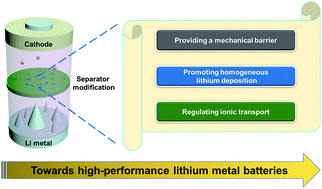Functional separators towards the suppression of lithium dendrites for rechargeable high-energy batteries
Abstract
Lithium metal battery (LMB) is considered to be one of the most promising electrochemical energy storage devices due to the high theoretical specific capacity and the lowest redox potential of metallic lithium; however, some key issues caused by lithium dendrites on the lithium metal anode seriously hinder its real-world applications. As an indispensable part of LMBs, the separator could serve as a physical barrier to prevent direct contact of the two electrodes and control ionic transport in batteries; it is an ideal platform for the suppression of lithium dendrites. In this review, the mechanism of lithium dendrite nucleation and growth are firstly discussed and then some advanced techniques are introduced for the precise characterization of lithium dendrites. On the basis of dendritic nucleation and growth principle, several feasible strategies are summarized for suppressing lithium dendrites by utilizing functional separators, including providing a mechanical barrier, promoting homogeneous lithium deposition, and regulating ionic transport. Finally, some challenges and prospects are proposed to clear the future development of functional separators. We anticipate that this paper will provide a new insight into the design and construction of functional separators for addressing the issues of lithium dendrites in high-energy batteries.

- This article is part of the themed collections: Recent Review Articles and Battery science and technology – powered by chemistry


 Please wait while we load your content...
Please wait while we load your content...